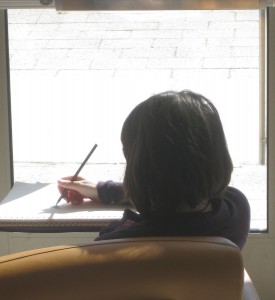“Let the familiar become strange and the strange familiar — the two rules of creativity.”
–Sam Keen, 1991
One of my best collaborators in the work of art-viewing lives with extreme visual impairment. One of the things I appreciate about working with him is the renewed sense of focus on what the work is all about in the first place.
Developing the skills of seeing does not require perfect vision. It requires curiosity.
Curiosity is what this particular collaboration is all about. Our goal is to catalyze a learning community around art and teaching among a group of clinical faculty, in order to offer the creative renewal necessary to consider some of the toughest issues shaping healthcare today: the marked decline of physical diagnosis skills, the incredible biopsychosocial complexity at stake in patient care, and the need for effective teamwork. These issues present tall orders for all in the enterprise of training novices.
What do these things mean for clinical educators? We have designed arts learning interventions in order to explore them. Our purpose in moving towards the arts was not to cultivate perfect observation skills. (Sometimes people assume that’s what art-viewing is for; it’s not). Rather, it was towards the goal of cultivating fresh eyes.
Cultivating fresh eyes for what—or whom—we think we already know is the key to effective, sustainable, adaptable clinical practice.

And we can’t do it alone. Fresh eyes require seeking to understand the experiences of others. Fresh eyes require differences. “Collaboration by difference,” writes Cathy Davidson, “respects and rewards different forms and levels of expertise, perspective, culture, age, ability, and insight, treating differences not as a deficit but as a point of distinction” (p. 100 of this transformative book). We live in one complex, entangled, dynamic, extraordinary world – and we need to see with others – and as others see – in order to begin to understand it.
Fresh eyes are, in my opinion, healthcare’s greatest resource. They are the human capability that saves lives – the human creativity that make for effective use of the technology. Mark Graber, renowned expert on misdiagnosis, writes, “Second opinions and consultations bring fresh eyes to examine a case, a powerful and effective way to find and correct diagnostic errors.”
The results of having fresh eyes go beyond improved diagnoses. They show up, well, wherever we look. In relationships, in work, everywhere.
Neuroscientists studying mammalian responses to novelty have found correlations between novelty and dopamine release. This is to say that it is probably very humanly (or mammalian-ly) easy to lose our curiosity once we think we already know something (or someone). So, cut yourself some slack! And at the same time, it is probably easier to cultivate excitement for something that is new than for something that is deeply familiar. But that’s not to say it cannot be done. It just takes becoming more conscious of where we put our curiosity—where we look—in the first place.
In my opinion, art-viewing can help our wacky monkey minds people learn to bridge the gap. Works of art are by nature foreign objects loaded with novelty and mystery. They reflect familiarity and newness at once. At the same time, they present facts to find, question, and synthesize. Art helps us learn to “let the familiar become strange, and the strange familiar.” From here we can find out where we allocate our curiosity in the first place.
Where do you care to look?


